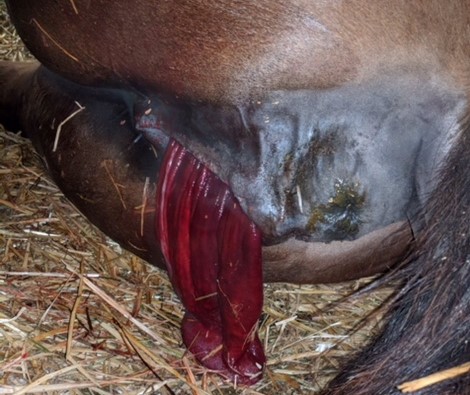 You bred your mare almost a year ago, 340 days to be exact, and have been waiting patiently. You have given her all of her pre-foaling vaccinations, adjusted her diet, and prepared a warm, well bedded stall. Everything is just right! So what can possibly go wrong? Well, most likely nothing. Mares foal uneventfully about 90% of the time, but when things do go south, they do so very quickly. So every mare owner needs to be prepared for the potential circumstance when things do go wrong.
You bred your mare almost a year ago, 340 days to be exact, and have been waiting patiently. You have given her all of her pre-foaling vaccinations, adjusted her diet, and prepared a warm, well bedded stall. Everything is just right! So what can possibly go wrong? Well, most likely nothing. Mares foal uneventfully about 90% of the time, but when things do go south, they do so very quickly. So every mare owner needs to be prepared for the potential circumstance when things do go wrong.
The Stages of Parturition
To understand when a foaling mare is in trouble, you must first know what defines a normal foaling (also called parturition). As implied above, the normal gestation for a mare is about 340 days, with the normal range being 325-360. Below is a brief description of the stages of parturition. For a more detailed explanation please see our article, Parturition in the Mare. The three stages are:
Stage 1- This is the early stage of labor and frequently includes episodes of pawing, laying down, looking at her flanks, sweating and general agitation. The mare is trying to position the foal into the birth canal during this phase, which usually lasts 1-4 hours. Stage one ends as the mare breaks her water (alantoic fluid). This release of alantoic fluid is produced as the foal enters the birth canal and ruptures the chorio-alantoic membrane.
Stage 2- This is the “active labor” phase, hallmarked by the water breaking and the foal being delivered. First to appear at the vulva will be the translucent “grey-white” amniotic membrane (or just the amnion), under which lies the foal, coming front feet first, followed closely by the head (in the “diving” position). This stage should last 10-20 minutes. Once the feet appear, steady progress should be being made throughout the process.
Stage 3- Expulsion of the fetal membranes, or placenta, occurs during stage three. The placenta should be passed within 3 hours of foaling.
As stated above, normally the foal’s front hooves are delivered first, with one slightly ahead of the other. The nose, and then the head, should present once the front legs are out to around the level of the knees. The entire foal should be delivered within about 10 minutes of the head appearing. During stage two of labor there should be signs of progression every 10 minutes once the water initially breaks. That means the water breaks, the amnion appears, the feet appear, the head is visible and finally delivery of the foal. The entire process should take approximately 15-30 minutes. The mare often lays down quietly post-foaling which possibly allows for blood to pass from the placenta to the foal via the still intact umbilical cord. The cord will break naturally when the mare eventually rises.
What Can Go Wrong?
Although most mares foal without any issues, there are problems that can arise during and after foaling. This is referred to as dystocia. Below is a review of what can go wrong at foaling:
- Extremity turned back - a leg(s) or head is turned back, forming a blockage of the birth canal. Sometimes the malposition can be corrected quickly by the attendant, sometimes professional help is required.
- Abnormal Presentation – back appearing at the birth canal, backwards presentation and various other mal-presentations including contracted tendons and malformed foal. This condition always needs veterinary assistance.
- Abnormally large foal- actually fairly rare.
- Red Bag (premature separation of the chori-allantois)- this is a true emergency that the foaling attendant must resolve. Instead of the usual white amnion appearing at the vulva, the bright red chorion appears which means the foal is being separated from its oxygen supply. The attendant must open the “red bag” and extract the foal and call the veterinarian. Note: the mare’s water does not break in this situation.
- Perineal tear/laceration- this occurs when the foal pushes a foot through the vagina into the rectum, causing a severe tear compounded by the mare’s forceful contractions. As severe as this condition looks, it is quite fixable.
- Retained Placenta- the placenta is considered retained after 3-4 hours. Oxytocin often helps. Contact your veterinarian for your dosage. For more information on this subject please see our article, Retained Placenta in the Mare. Numerous other conditions can occur at parturition, but the above are the most common and the ones the foaling attendant should be aware of. One cannot always prevent these problems but there are some guidelines to help get your mare through a successful foaling.
Approaches to Dystocia Correction
Although a normal foal can often remain alive for up to an hour after the water breaks, we must keep in mind that many dystocias are caused by abnormal and/or dead foals. That said, time and expediency are of a premium, so acting early and efficiently is important. Though the foal attendant can often alleviate the problem with a gentle tug or manipulation, the veterinarian should be called as soon as it is apparent that something is amiss.
There are two basic approaches to dystocia correction: one while the mare is standing (sometimes with an epidural as adjuvant therapy) and the other while under general anesthesia.
Standing Correction Approach
This can often be performed at the ranch, usually with sedation. The mare is prepped around her perineal area, the tail is wrapped and the veterinarian will check the foal’s position and attempt to correct any problems with a combination of repelling (pushing the foal/fetus back inside) and traction. The viability of the fetus is evaluated at this time if possible. After several minutes of standing manual correction without success, other approaches should be considered.
General Anesthesia Approach
This method is usually done in a hospital setting but under certain circumstances may be done on the ranch. There are three general procedures to correct dystocias while under general anesthesia. They are manual extraction, cesarean and fetotomy.
With the Manual Extraction option, the mare arrives at the equine hospital where her vital status is assessed quickly and blood is drawn for pre-anesthetic evaluation. The dystocia is evaluated while an IV line is placed and she is quickly induced with a general anesthetic. A team approach is essential here with technicians monitoring anesthesia, clipping and prepping the abdomen (for possible cesarean section), monitoring the passage of time, and prepping the perineal area all while the mare’s rear quarters are elevated (to allow easier fetal manipulation). The veterinarian will again attempt to correct any positioning issues and extract the fetus with the aid of snares and leg chains. If the fetus cannot be extracted promptly then cesarean or fetotomy must be considered. A live foal dictates a cesarean section, while a dead foal leaves the option for a fetotomy on the table.
When done properly a C-section, an operation by which a fetus is taken from the uterus by cutting through the walls of the abdomen and uterus, can lead to a live, viable foal and a mare able to reproduce again. The biggest drawback to the C-section is the cost which can often cost anywhere from $8000.00-$12000.00.
A fetotomy, cutting apart of the fetus to enable remove from the uterus, is only performed when the fetus has passed away and is the only way to extract vaginally. It should only be done by an experienced veterinarian. Otherwise damage can be done to the mare, jeopardizing her future reproductive life. Personally, this author prefers a C-section over fetotomy.
Basics to Prepare for Foaling
You should always be prepared for when your mare is going to foal. Our article, Preparation for Foaling, details what to consider before the little one arrives. Here are some other suggestions to keep in mind:
- Have your veterinarian’s number at hand for all foalings.
- Attend all foalings- there are devices and milk test kits to help you “predict” foaling. (“Predict a Foal”)
- Know the stages of parturition and the timeline.
- If progress isn’t made every 10 minutes during Stage 2, call your veterinarian.
- If progress isn’t made in Stage 2, check to make sure there are two feet and a nose present. If not, try to gently correct that, upon the advice of your veterinarian.
- If your mare is in trouble, walk her to slow down her contractions until the veterinarian arrives.
- Be prepared, especially for a red bag. Rehearse in your mind what to do before the mare is ready to foal. Check YouTube for “red bag videos”.
- Have prompt access to a trailer or truck should complications arise and the mare or foal need to be taken to the hospital facility
- Have foaling kit ready. Find a list of items here Preparation for Foaling.
Most foalings go quickly and uneventfully, but occasionally there can be trouble. The mare owner that is prepared and informed can often recognize problems and obtain a good outcome. Remember the timeline and when in doubt, call your veterinarian.


Log in to join the conversation.